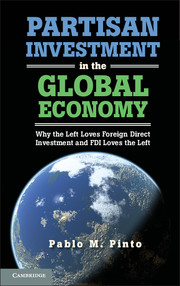 Partisan Investment in the Global Economy
Partisan Investment in the Global Economy Published online by Cambridge University Press: 05 March 2013
Introduction
As discussed in Chapter 1, foreign direct investment (FDI) flows have become an important part of total investment flows, and now play a major role in growth and development. National and local governments across the planet have adopted various types of policies to attract or deter inward FDI. Allegedly, developed countries have converged on less discriminatory regimes toward foreign investors. A tally of the number of changes in foreign investment regulation seems to underscore this trend (Table 1.2). However, Table 1.2 also shows that the number of restrictive measures have increased dramatically since 2001, probably as a response to the global recessions of 2001 and 2008, and regional crises inmost corners of the world. There is also great variance in the orientation of investment regimes across countries and over time, even among OECD countries. In recent years, discontent toward foreign investors has become rampant not only in crisis-stricken countries, but is expressed in a rhetoric that resonates with the the policy debates of the 1970s. In this chapter, I present a formal derivation of the logic behind the partisan theory of foreign investment, which aims at explaining the observed variance in regulatory regimes toward foreign investment and the positive association between left-leaning governments and direct investment flows.1Given that the conditions for investment are present, domestic politics is likely to play a major role in shaping how foreign investment is regulated, or how open countries are to FDI.
To save this book to your Kindle, first ensure [email protected] is added to your Approved Personal Document E-mail List under your Personal Document Settings on the Manage Your Content and Devices page of your Amazon account. Then enter the ‘name’ part of your Kindle email address below. Find out more about saving to your Kindle.
Note you can select to save to either the @free.kindle.com or @kindle.com variations. ‘@free.kindle.com’ emails are free but can only be saved to your device when it is connected to wi-fi. ‘@kindle.com’ emails can be delivered even when you are not connected to wi-fi, but note that service fees apply.
Find out more about the Kindle Personal Document Service.
To save content items to your account, please confirm that you agree to abide by our usage policies. If this is the first time you use this feature, you will be asked to authorise Cambridge Core to connect with your account. Find out more about saving content to Dropbox.
To save content items to your account, please confirm that you agree to abide by our usage policies. If this is the first time you use this feature, you will be asked to authorise Cambridge Core to connect with your account. Find out more about saving content to Google Drive.